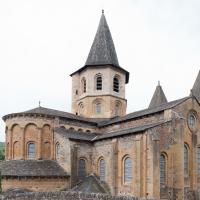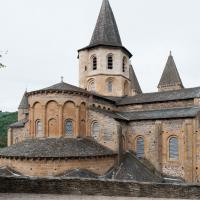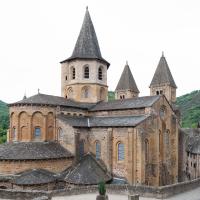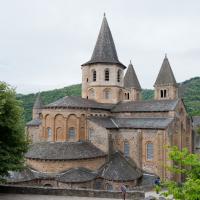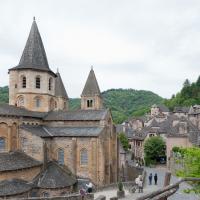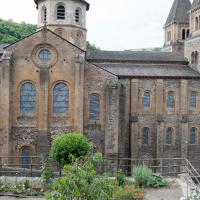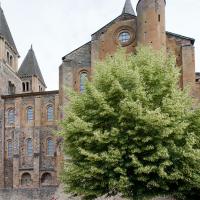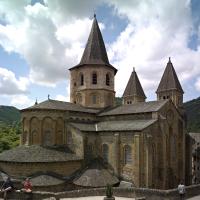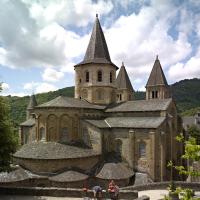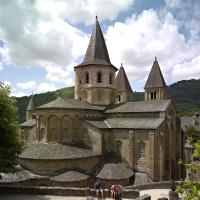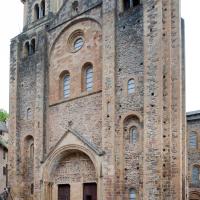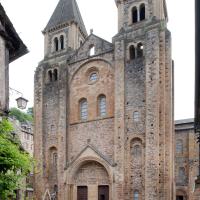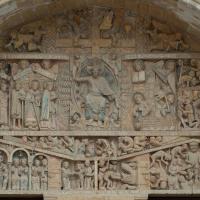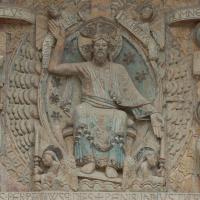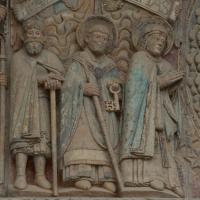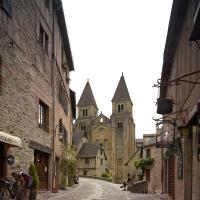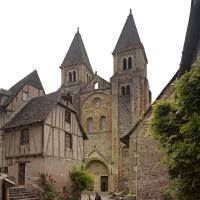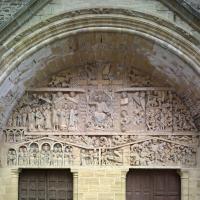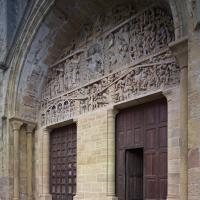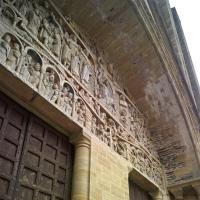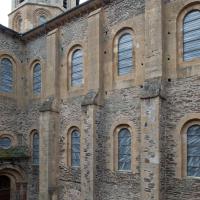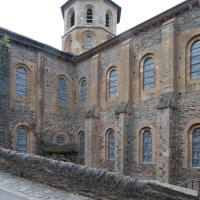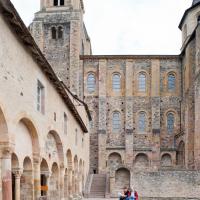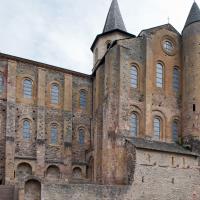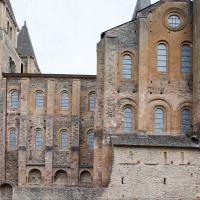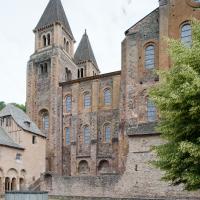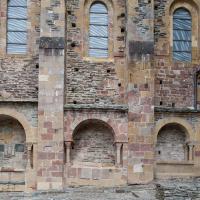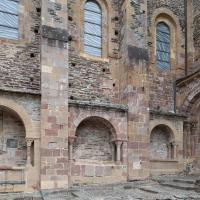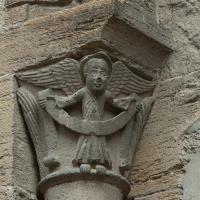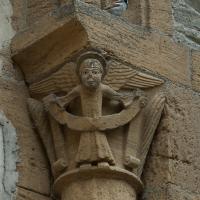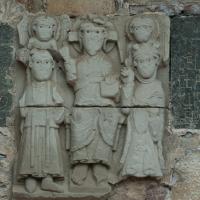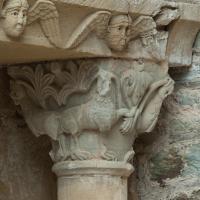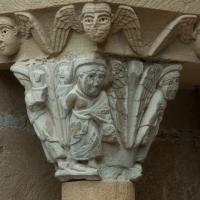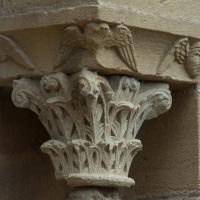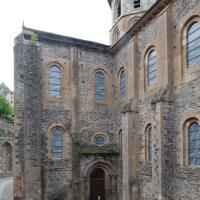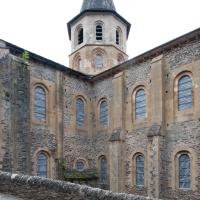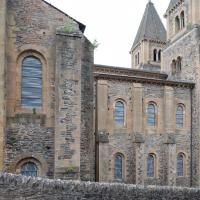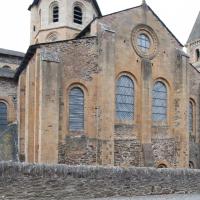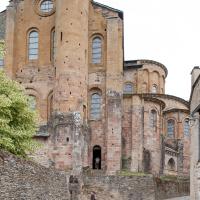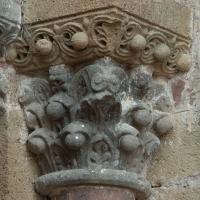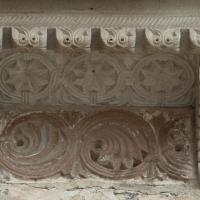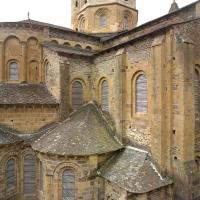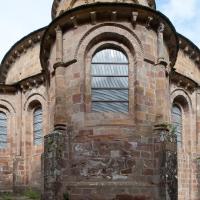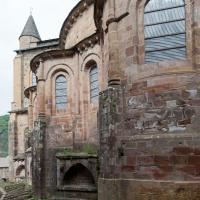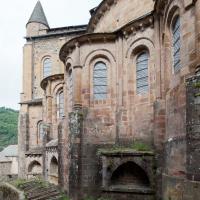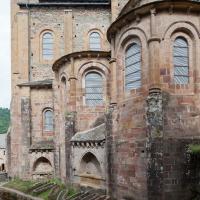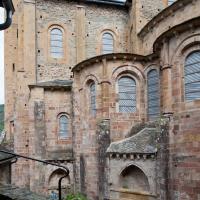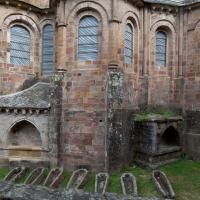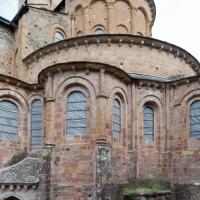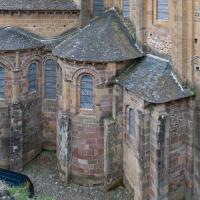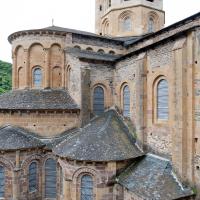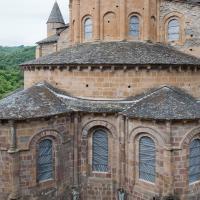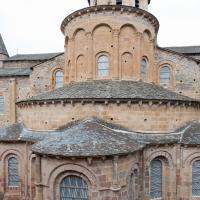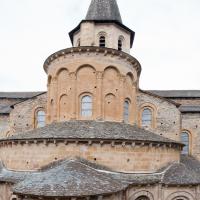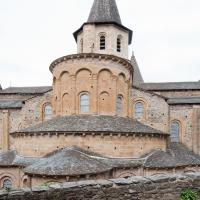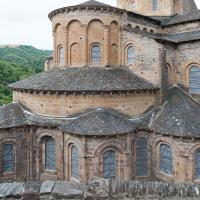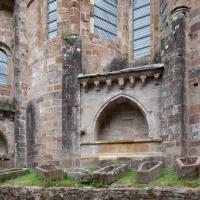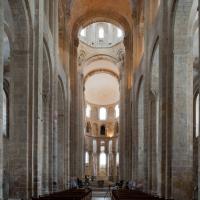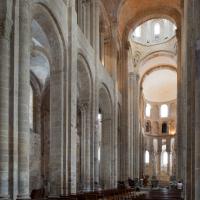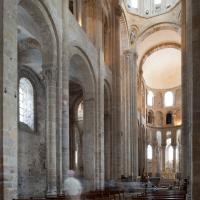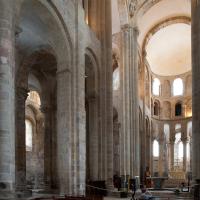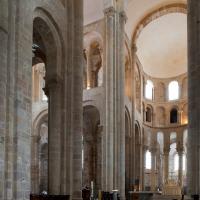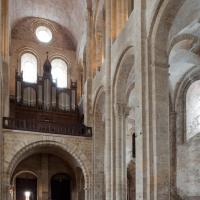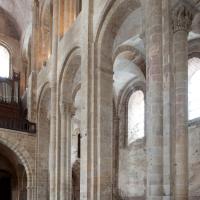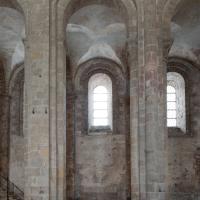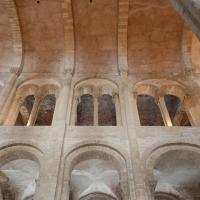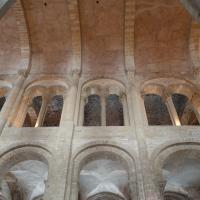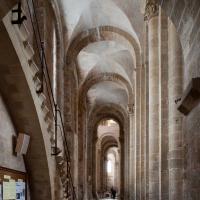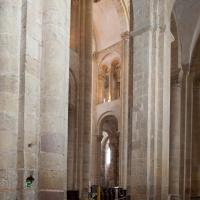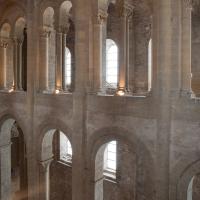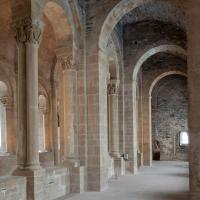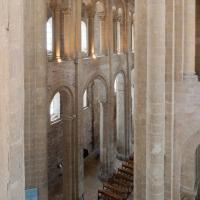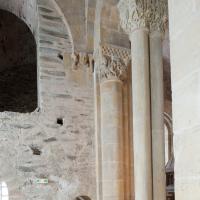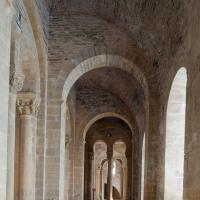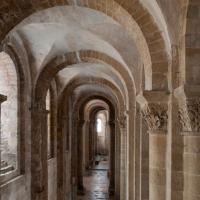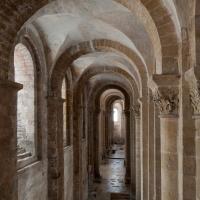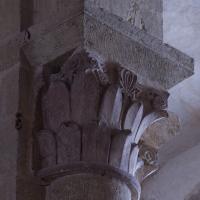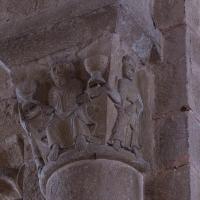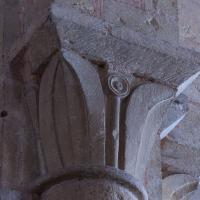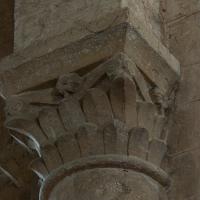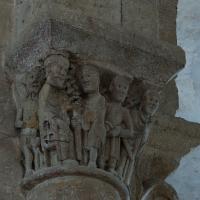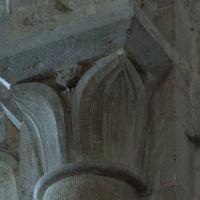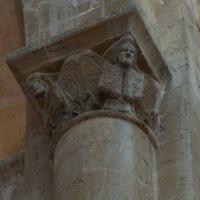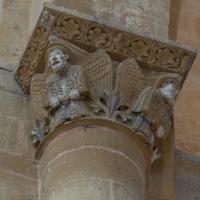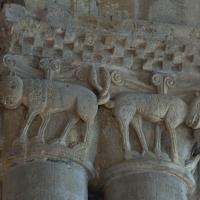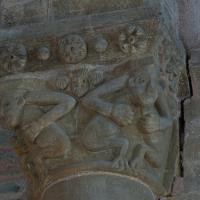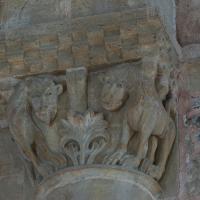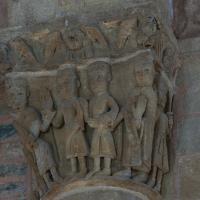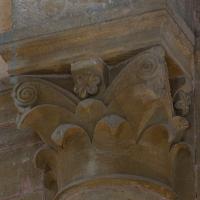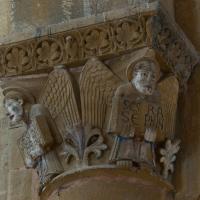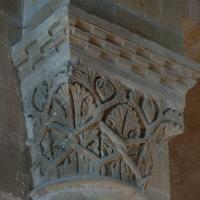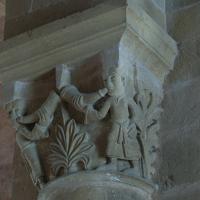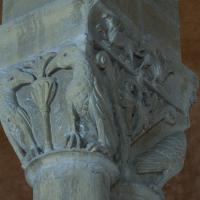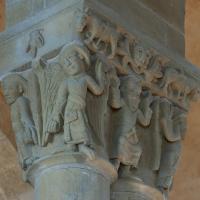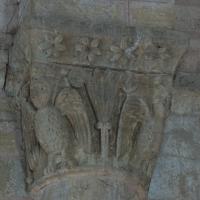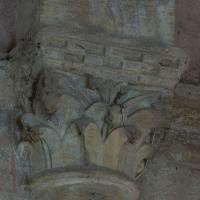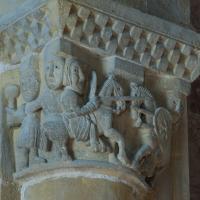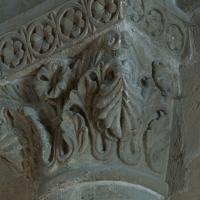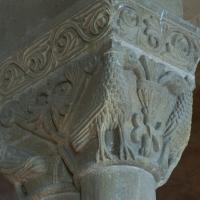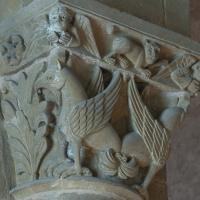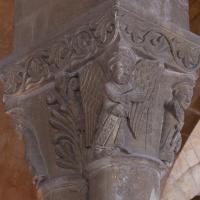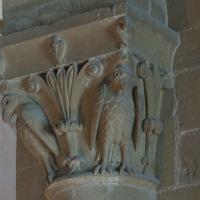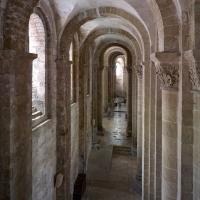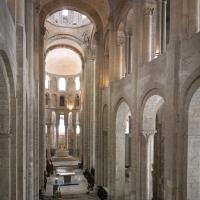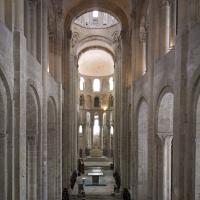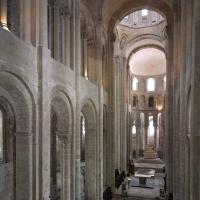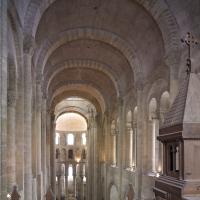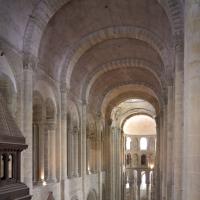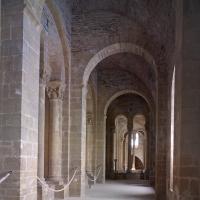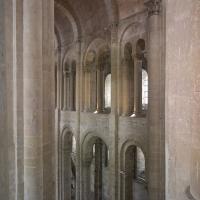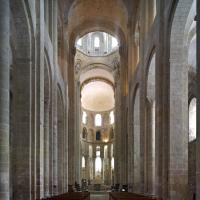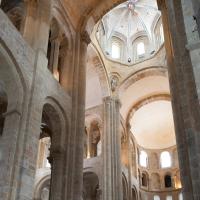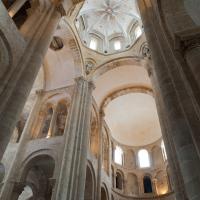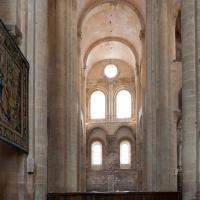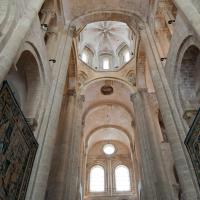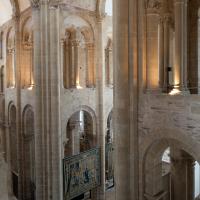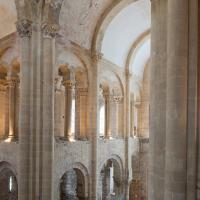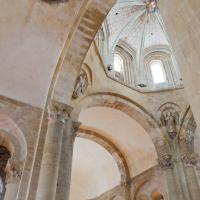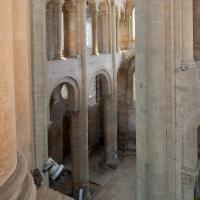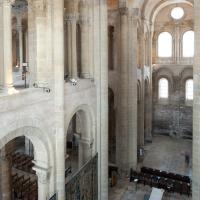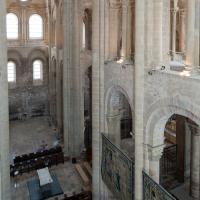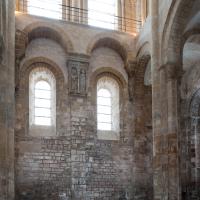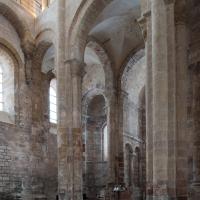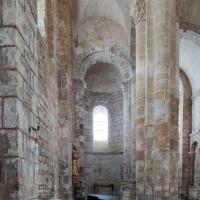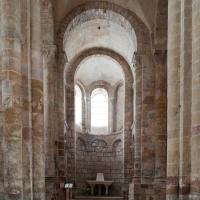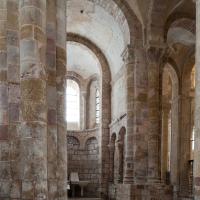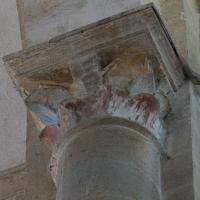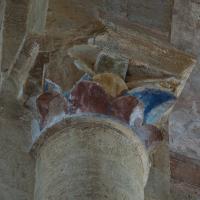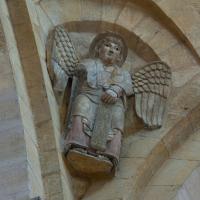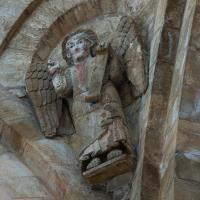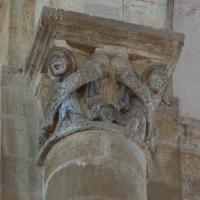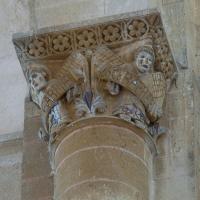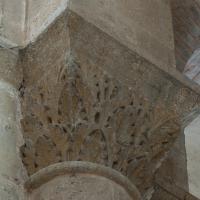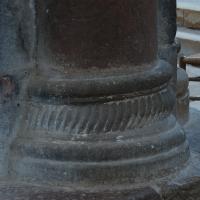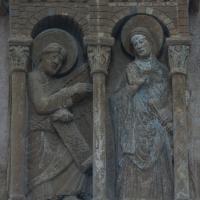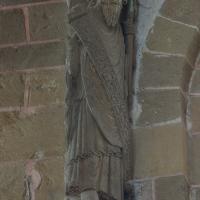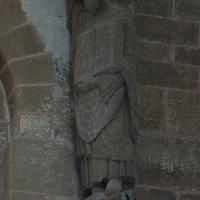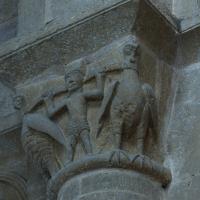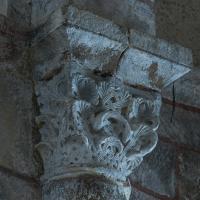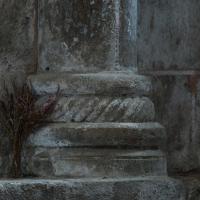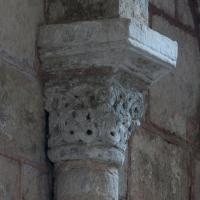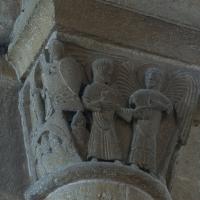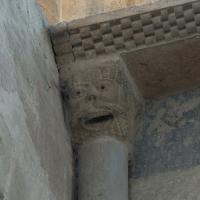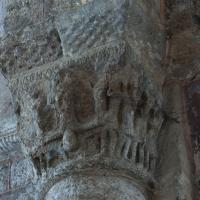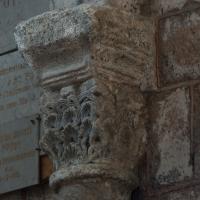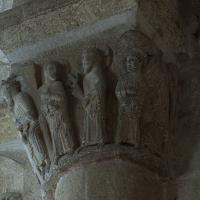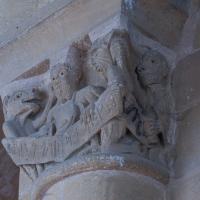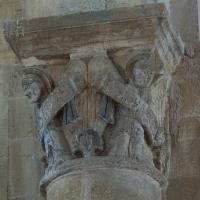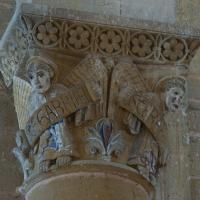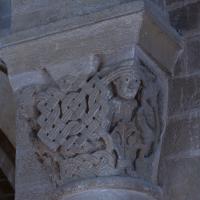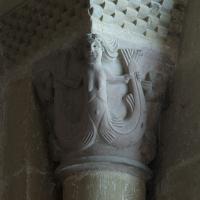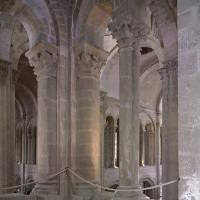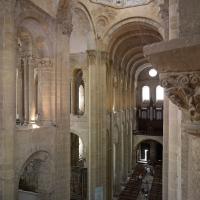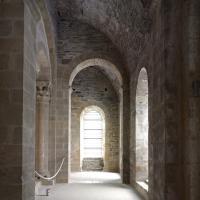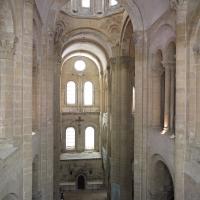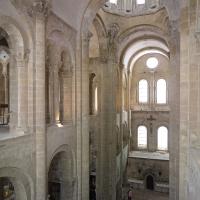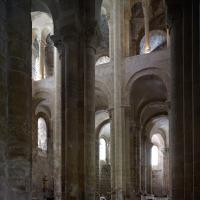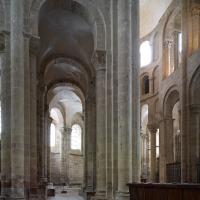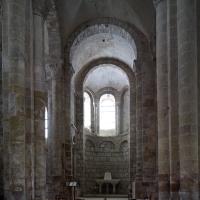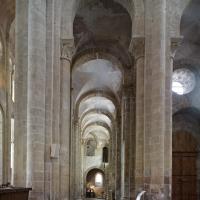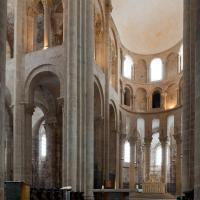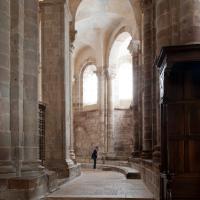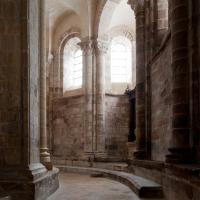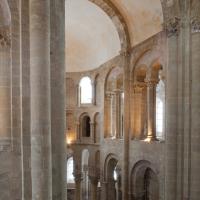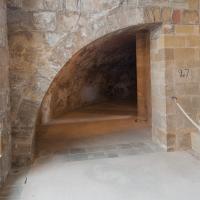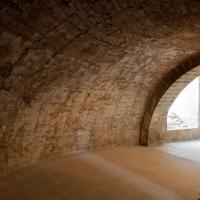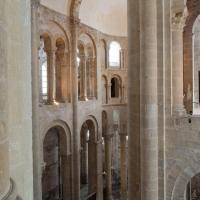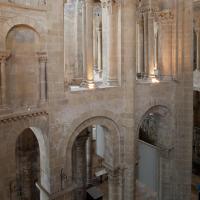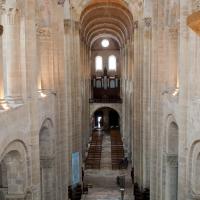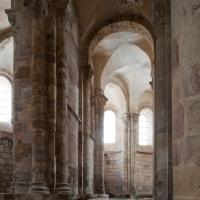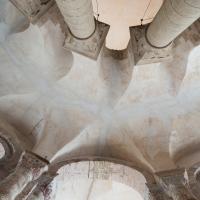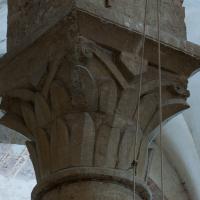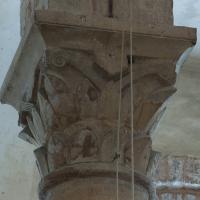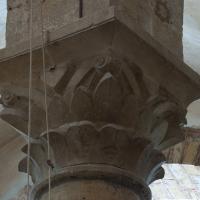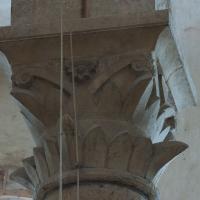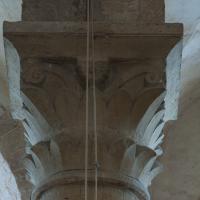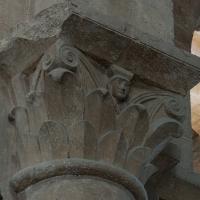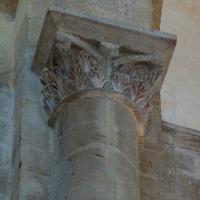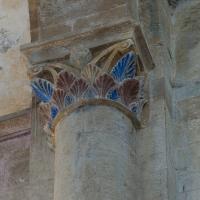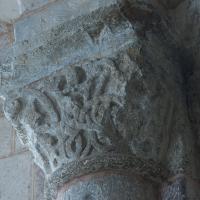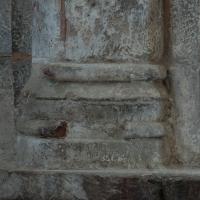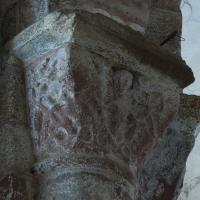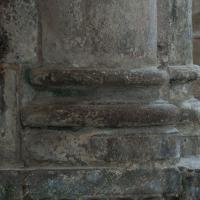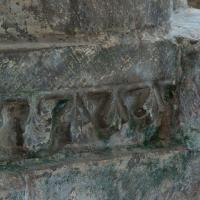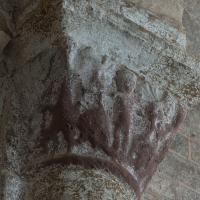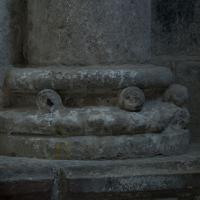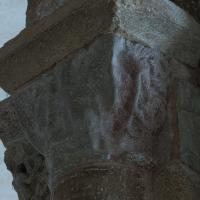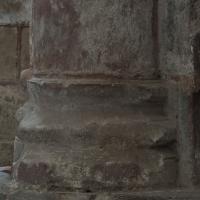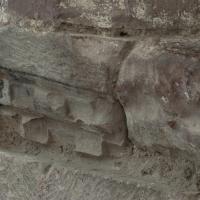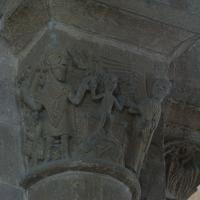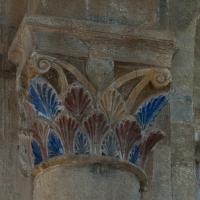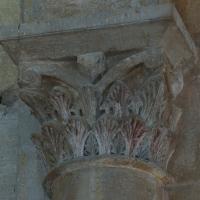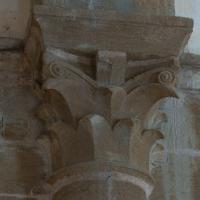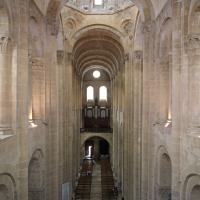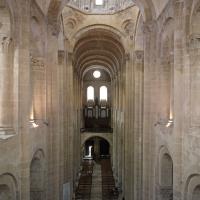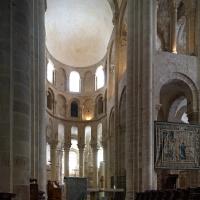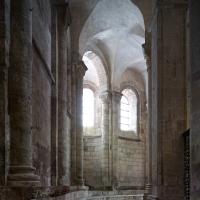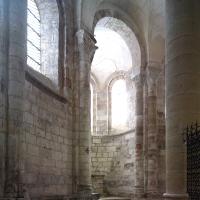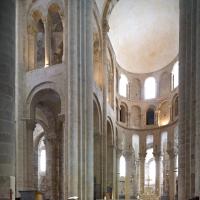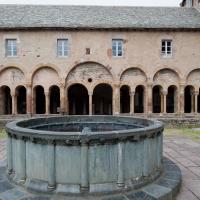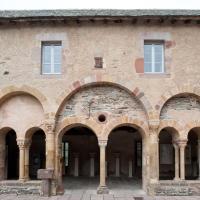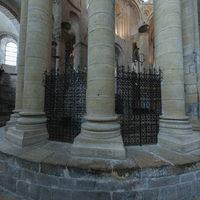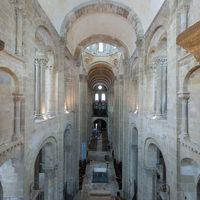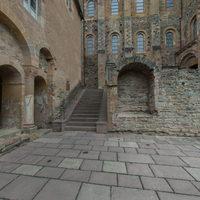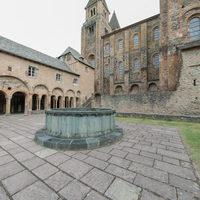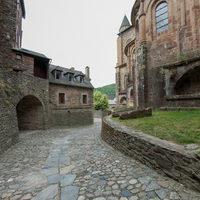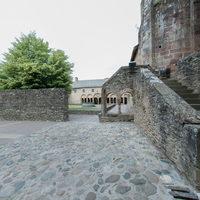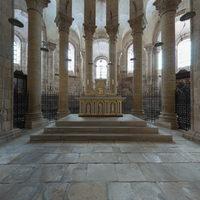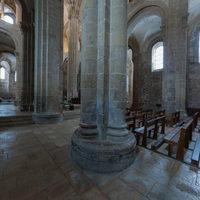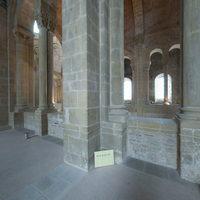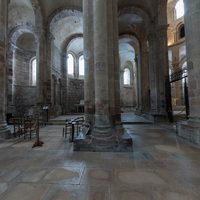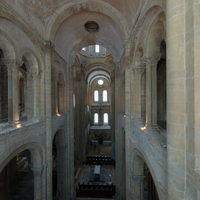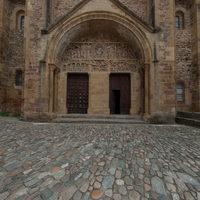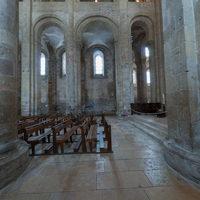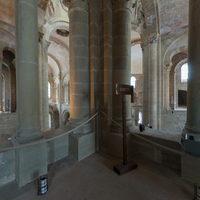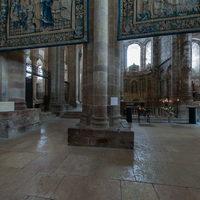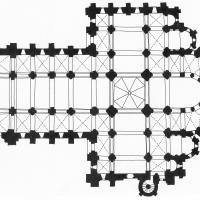Images
VR Tour
Notes
Date
Begun ca. 1041
Sculptural Program
The western frontispiece is adorned with a proliferation of sculpture, all of which is localized in the rounded tympanum above the doorway. This sculptural program can be defined thematically as a Last Judgment. The sculpture is organized in three registers. In the center of the middle register, a stern Christ sits frontally, framed by a mandorla, resting on wavy clouds, where he is depicted separating the elect from the damned. Latin inscriptions identify the actors in this scene and convey the iconographic program. The text also imposes a visual structure that simultaneously delineates the individual subjects and serves as a thread that unifies the composition.
In the top register, two angels in profile swoop down at a sharp angle, bearing Instruments of the Passion, the lance on the left and the nails on the right. These angels appear to carry the imposing cross, which meets the upper edge of Christ's mandorla. Fanning out from these two raked angels, an angel appears at each end of the lateral arm of the cross. Two more angels, these depicted with trumpets at their lips, frame the tympanum, their wings spread, following the architectonic frame of the arch overhead. These trumpeting angels are splayed out, their knees bent and feet flexed, and wide swaths of drapery fold sharply around them, in some instances pushing upward in defiance of gravity.
In the second register from the top, we see the cortege of the elect at Christ's right hand, his gesture matched by his lower body, with his left knee and foot angled downward, apparently weighed down by the souls of the damned. A flurry of undulating clouds appears above the heads of this procession, which is capped by four angels bearing scrolls inscribed with virtues. Many of these figures are identifiable, although the identities of some remain elusive. At the head of the procession is the Virgin, who is followed by Saint Peter, the hermit-founder Dadon, the crosier-bearing abbot Bégon--who leads Charlemagne by the hand--and a group of monks with offerings. In the triangular section at the left edge of this register are smaller figures depicting Saint Jerome, another saint (probably either Saint James the Greater or Saint Caprais, the local bishop whose cult was subsumed by Saint Foy's), a female saint carrying a palm frond (perhaps Saint Alberte), and a beneficiary of a miracle of Saint Foy. To Christ's left is a quaternary of angels: one holds an open book, another a sword and shield, a third is presented as a standard-bearer, and the last grasps a censer with both hands. To the right of this group is a depiction of hell, where demons can be seen gnawing on, crushing, roasting, and torturing the damned, in some cases assisted by various weapons.
In the interstitial zone above the lowest register, we see an arcade and an altar. At the right end of this arcade, a supplicant Saint Foy appears, nimbed, before the Manus Dei, which here appears with a cruciform-inscribed nimbus and a sleeve of clouds. Continuing along this intermediary zone, we see angels lifting the lids from tombs, the figures inside them in various stages of reanimation. In the center of this zone is a crouched Saint Michael facing the Devil, weighing souls, although only vestiges of the scales remain. A fiery scene of hell fills the remainder of this zone.
The lowest register is outlined by two inscribed triangular spaces. On the left, below the images of Saint Foy and the resurrected bodies, is a representation of the paradise of Abraham, here rendered beneath a rounded arcade. In the center are the antechambers of heaven and hell, angels helping along the elect, and demons seen shoving a nude figure into the wide-eyed, gaping Hellmouth, which is framed by a rectilinear doorway leading to hell. In this register of the hell scene, we see a knight in mail, tumbling from his horse, being poked and prodded. There are female figures in various states of undress, another hanging and further roasting. Snaking tendrils and blocky, grasping fingers punctuate and unify this otherwise chaotic scene.
There has been debate on the matter of dating the sculpture on the western frontispiece at Conques. Bousquet, Gaillard, Deschamps, and Bernouilli believe this portal was executed in the first quarter of the twelfth century; Zarnecki and Rupprecht have argued for the second quarter; Durliat, 1130-1135; Fau and Aubert, ca. 1140; Christe, Hubert, and Bréhier, after 1160-1170. These differences are the result of stylistic analysis and divergent interpretations of extant documentation.
This portal has traditionally been viewed as a kind of bridge between Romanesque and Gothic, where its thematic content and formal organization are interpreted as an intermediate phase between two poles. This shows residue of the evolutionary model applied to medieval sculpture, and it complicates the matter of dating. In more reductive terms, this tympanum has been taken to exemplify Romanesque Last Judgment portals as a bleak portrayal of the Last Judgment, unlike later treatments of the same narrative that place more emphasis on soteriology and leave greater room for redemption.
Location
Bibliography
Aubert, M., Eglise de Conques, Paris, 1939
Barral-Altet, X., "Le pavement roman de l'église Saint-Foy de Conques," Bulletin monumental, vol. 133:1, 1975, pp 73-80
Bernoulli, C., Skulpturen der Abtei Conques-en-Rouergue, Basel 1956
Bonne, J.-C., Art roman de face et de profile: le tympan de Conques, Paris, 1984
Bouché, A.-M., "Vox imagines: anomaly and enigma in Romaesque art," The Mind's Eye: Art and Theological Argument in the Middle Ages, Ed. Jeffrey Hamburger and Anne-Marie Bouché, Princeton, 2006, pp 306-335
Bouillet, Abbé A., Eglise et le trésor de Conques (Aveyron) Nimes, 2003
Castiñeiras, M., "Da Conques a Compostella: retorica e performance nell'era dei portal parlanti," Medioevo: Immagine e memoria. Atti del Convergo internazionale di studi, Parma, 23-28, septembre, 2008, Ed. Arturo Carlo Quintavalle, Milan, 2009, pp 233-251
Chambine, J. de, Sainte-Foy de Conques, Paris
Darcel, A., Trésor de l'église de Conques, Paris, 1861
Delmas, C.; Fau, J.-C.; Kumurdjian, A., Conques, Millau, 1994
Dengreville, R.; Renoue, M., Conques: moyenâgeuse, mystique, contemporaine, Rodez, 1997
Deyres, M., "Les grilles de Sainte-Foy de Conques," Cahiers de civilization médiévale, Xe-XIIe siècles, vol. 15:2:58, 1072, pp 143-150
----, "L'intervention du theme bénédictin à Sainte-Foy de Conques," Bulletin monumental, vol. 129:3, 1971, pp 183-191
----, "Le local à l'usage de sacristie à Sainte-Foy de Conques," Annales du Midi: Revue archéologique, historique et philologique de la France méridionale, vol. 83:103, 1971, pp 337-339
----, "Le portail occidental de Sainte-Foy de Conques," Bulletin de la Société nationale des antiquaires de France, 1969, pp 194-202
Durliat, M., Sculpture romane de la route: de Conques à Compostelle, Mont-de-Marsan, 1990
Enfer et paradis:l'au-delà dans l'art et la littérature en Europe: actes du colloque organisé par le Centre européen d'art et de civilisation médiévale, Conques, 1994, published Conques, 1995
Fau, Jean-Claude, Conques, Bordeaux, 2006
----, "Les tables d'autel romanes de Sainte-Foy à Conques," Bulletin monumental, vol. 134:1, 1976, pp 49-52
----, "Sainte-Foy de Conques en Rouergue. A propos de la découverte d'un element du chancel du Xe siècle," Archeologia, vol. 94, 1976, pp 55-57
-----, Les Chapiteaux de Conques, Toulouse, 1956
Gaud, H.; Jeannin, E., Conques, Moisenay, 2004
Gandiol-Coppin, B., "Initiation: les églises romanes de pèlerinage," Archeologia, vol. 211, 1986, pp 53-62
Kendall, C. B., "The voice in the stone: the verse inscriptions of Ste-Foy of Conques and the date of the tympanum," Hermeneutics and Medieval Culture, Ed. Patrick J. Gallacher and Helen Damico, Albany, 1989, pp 163-182
Poux, N., "Regards sur le tympan de Conques au début du XVIIIe siècle," Bulletin monumental, , 2001, 239-42
Renoue, M., Sémiotique et perception esthétique: Pierre Soulages et Sainte-Foy de Conques, Limoges, 2001
Sauerländer, W., "OMNES PERVERSI SIC SUNT IN TARTARA MERSI. Skulptur als Bildpredigt. Das Weltgerichtstympanon von Sainte-Foy in Conques," Jahrbuch der Akademie der Wissenschaften in Göttingen, 1979, pp 33-47
Scheingorn, P. (ed) and Clark, A. A., Book of Sainte-Foy, Philadelphia, 1995
----- and Ashley, K., Writing Faith: Text, Sign and History in the Miracles of Ste Foy, Chicago, 1999
See, G. D., "La cathédrale des anges. Conques Lecture cinématographique des tympans de l'époque romane avec le Passant et L'ouvrier Compagnon du Tailleur de pierre, devant le grand portail de Sainte-Foy de Conques," Centre International d'études romanes: Revue trimestriel, vol. 2, 1974, pp 11-22
Strecke, R., Romanische Kunst und epische Lebensform. Das Weltgericht von Sainte-Foy in Conques, Berlin, 2002
Taussat, R., Chapiteaux, Sainte-Foy de Conques, Rodez, 2006
Vergnolle, E., "La sculpture romane de la route de Saint-Jacques à Compostelle," Bulletin monumental, , 1991, 130-4


